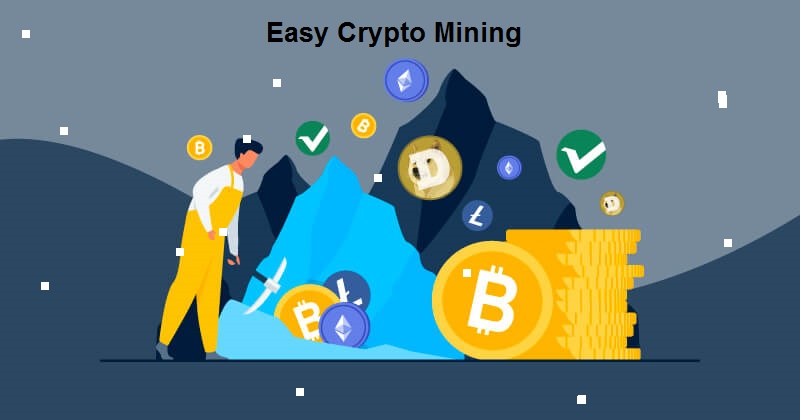
Cryptocurrency mining has become a buzzword in the world of digital finance. With the rise of Bitcoin, Ethereum, and other altcoins, many people are eager to get involved in crypto mining by purchasing crypto mining hardware or other means. However, the process can seem intimidating, especially for beginners. The good news is that crypto mining doesn’t have to be complicated. In this guide, we’ll break down the basics of easy crypto mining, explore the most accessible methods, and provide tips to help you get started.
What is Crypto Mining?
Crypto mining is the process of validating transactions on a blockchain network and adding them to the public ledger (blockchain). Miners use powerful computers to solve complex mathematical problems, and in return, they are rewarded with cryptocurrency. This process not only secures the network but also introduces new coins into circulation.
While mining was once a niche activity reserved for tech-savvy individuals, advancements in technology have made it more accessible to the average person. Today, there are several ways to mine cryptocurrency, even if you don’t have a background in computer science or access to expensive hardware.
Why is Crypto Mining Popular?
- Potential for Profit: Mining can be a lucrative way to earn cryptocurrency, especially during bull markets when coin prices are high.
- Decentralization: Mining supports the decentralized nature of blockchain networks, ensuring that no single entity controls the system.
- Passive Income: Once set up, mining can generate passive income with minimal ongoing effort.
- Learning Opportunity: Mining provides a hands-on way to learn about blockchain technology and cryptocurrencies.
Easy Crypto Mining Methods for Beginners
If you’re new to crypto mining, it’s important to start with methods that are simple, affordable, and low-risk. Here are some of the easiest ways to get started:
1. Cloud Mining
Cloud mining is one of the simplest ways to mine cryptocurrency without owning any hardware. Instead of setting up and maintaining your own mining rig, you rent computing power from a cloud mining provider. These companies operate large-scale mining farms and allow users to purchase mining contracts.
Pros:
- No need to buy or maintain hardware.
- Accessible to anyone with an internet connection.
- Low upfront costs.
Cons:
- Lower profits compared to traditional mining.
- Risk of scams (always choose reputable providers).
- Limited control over mining operations.
Popular Cloud Mining Platforms:
- Genesis Mining: A trusted platform offering contracts for Bitcoin, Ethereum, and other cryptocurrencies.
- Hashflare: Known for its user-friendly interface and flexible contracts.
- NiceHash: Allows users to buy and sell hashing power.
2. CPU Mining
CPU mining involves using your computer’s central processing unit (CPU) to mine cryptocurrency. While this method is less powerful than GPU or ASIC mining, it’s a great option for beginners who want to dip their toes into mining without investing in specialized hardware.
Pros:
- No additional hardware required (uses your existing computer).
- Easy to set up.
- Low energy consumption compared to other methods.
Cons:
- Limited profitability for most cryptocurrencies.
- Slower mining speeds.
- Not suitable for mining Bitcoin or other high-difficulty coins.
Best Coins for CPU Mining:
- Monero (XMR): Designed to be CPU-friendly and resistant to ASIC mining.
- VerusCoin (VRSC): A lesser-known coin that is profitable for CPU mining.
- Aeon (AEON): A lightweight cryptocurrency optimized for CPU mining.
3. GPU Mining
GPU mining uses graphics processing units (GPUs) to mine cryptocurrency. GPUs are more powerful than CPUs and can handle more complex calculations, making them ideal for mining a wider range of coins.
Pros:
- Higher profitability compared to CPU mining.
- Versatile (can mine multiple cryptocurrencies).
- GPUs can be repurposed for gaming or other tasks.
Cons:
- Higher upfront cost for GPUs.
- Increased energy consumption.
- Requires some technical knowledge to set up.
Best Coins for GPU Mining:
- Ethereum (ETH): Although Ethereum has transitioned to proof-of-stake, other coins like Ravencoin (RVN) and Ethereum Classic (ETC) are still GPU-mineable.
- Ravencoin (RVN): Designed for GPU mining and focused on asset transfer.
- Ergo (ERG): A decentralized blockchain optimized for GPU mining.
4. Mining Pools
Mining pools allow individual miners to combine their computing power and share the rewards. This method increases the chances of earning cryptocurrency, especially for miners with limited resources.
Pros:
- Higher chances of earning rewards.
- Steady income stream.
- Accessible to small-scale miners.
Cons:
- Pool fees reduce overall profits.
- Requires trust in the pool operator.
- Less control over mining operations.
Popular Mining Pools:
- Slush Pool: One of the oldest and most reputable Bitcoin mining pools.
- Ethermine: A leading pool for Ethereum and other GPU-mineable coins.
- F2Pool: Supports a wide range of cryptocurrencies.
5. Browser Mining
Browser mining allows users to mine cryptocurrency directly from their web browser. This method uses JavaScript to harness the computing power of website visitors. While it’s not highly profitable, it’s an easy way to earn small amounts of crypto.
Pros:
- No hardware or software required.
- Completely free to start.
- Minimal impact on system performance.
Cons:
- Very low profitability.
- Ethical concerns (some websites mine without user consent).
- Limited to a few cryptocurrencies.
Popular Browser Mining Platforms:
- CoinHive: A JavaScript miner for Monero (note: ensure you have user consent).
- CryptoTab: A browser extension that mines Bitcoin while you browse.
Tips for Successful Crypto Mining
- Do Your Research: Before investing in any mining method, research the cryptocurrency, hardware, and platforms to ensure they align with your goals.
- Calculate Costs: Consider the cost of hardware, electricity, and maintenance to determine if mining is profitable for you.
- Stay Updated: The crypto mining landscape is constantly evolving. Stay informed about new coins, technologies, and regulations.
- Secure Your Earnings: Use a secure wallet to store your mined cryptocurrency and enable two-factor authentication (2FA) for added security.
- Start Small: Begin with low-cost methods like CPU mining or cloud mining to gain experience before scaling up.
Is Crypto Mining Still Profitable in 2023?
The profitability of crypto mining depends on several factors, including the price of the cryptocurrency, mining difficulty, and electricity costs. While mining Bitcoin with ASICs or GPUs can be expensive and competitive, there are still opportunities to profit from mining altcoins or using alternative methods like cloud mining.
For beginners, the key is to start small, minimize costs, and focus on coins with lower mining difficulty. As you gain experience and confidence, you can explore more advanced mining techniques.
Conclusion
Crypto mining doesn’t have to be complicated or expensive. With the right approach, even beginners can start earning cryptocurrency with minimal effort. Whether you choose cloud mining, CPU mining, or join a mining pool, there’s a method that suits your budget and skill level.
Remember, the world of cryptocurrency is highly volatile, and mining is no exception. While it can be a rewarding venture, it’s important to approach it with caution and realistic expectations. By following this guide to easy crypto mining and staying informed, you’ll be well on your way to becoming a successful crypto miner.

